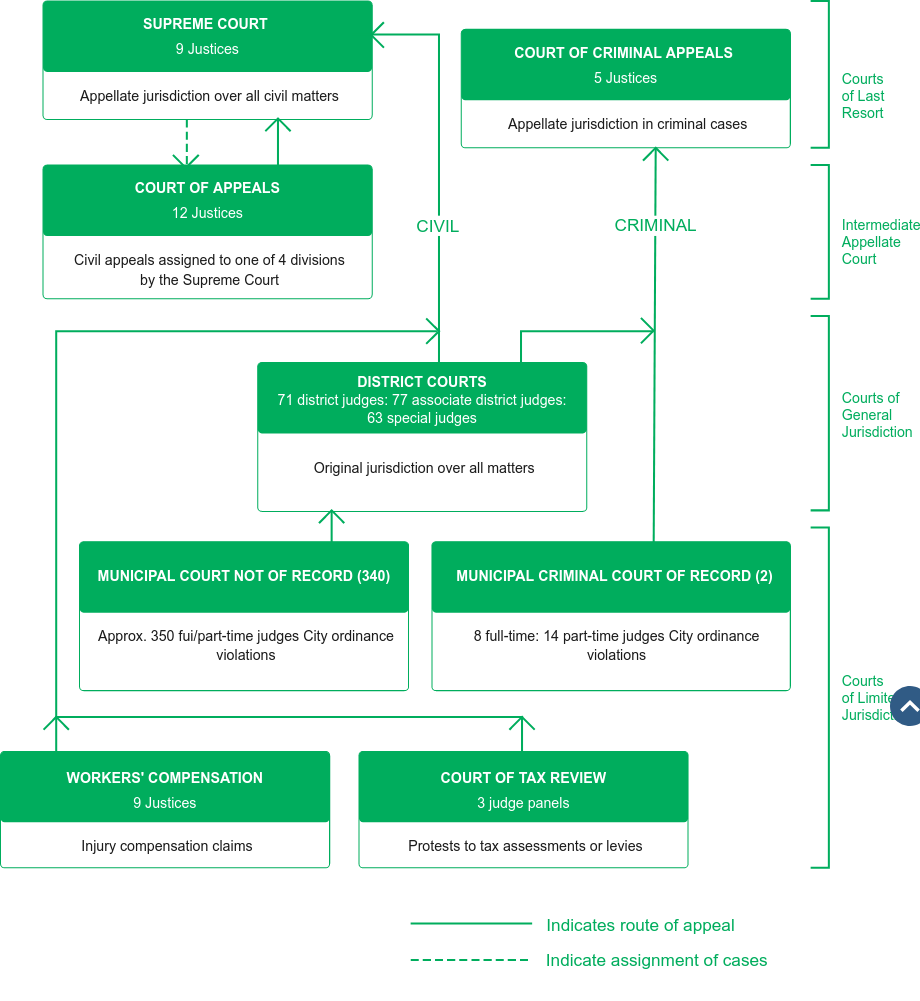Understanding The Sooner State's Criminal Justice System
Oklahoma’s Criminal Justice system is responsible for providing public safety by deterring and preventing crime, punishing offenders, documenting these interactions with both arrest records and criminal records, and reintroducing those who have served their time back into the community. The criminal justice system is based on the body of laws that define crimes and offenses, and specify what punishments are appropriate for those crimes.
Oklahoma Criminal Code doesn’t have categories for felonies or misdemeanors. Instead, each crime is described as a felony or misdemeanor charge. Further, some crimes can be categorized as both depending on the nature, the target, and the outcome of the crime.
Felonies in Oklahoma are serious crimes and come with harsher punishments that typically involve prison, fines, and loss of certain rights.
- First-degree murder or manslaughter
- Robbery with a dangerous weapon
- Drug trafficking or aggravated drug trafficking
- Bribery, fraud, and gambling
- Assault and battery with a dangerous weapon
- Assault and battery resulting in serious bodily harm
- Rape and other sex crimes such as possession of child pornography
A misdemeanor in Oklahoma a less serious crime, and common punishments include probation, county jail time, fines, or a combination of all three.
- Assault and battery with no serious injury
- Breaking and entering
- Domestic violence
- Possession of certain controlled substances
- DUIs
- Shoplifting and theft
- Offenses committed by juveniles
The Oklahoma City Bombing Case was one of the highest profile cases held by Oklahoma Courts. The act of terrorism conducted by Timothy McVeigh was of such notoriety that the court eventually opted to transfer his case Denver.
How the Oklahoma Courts are Organized

Oklahoma is unique in that it has a four level court system rather than the standard three level system. It is designed to handle the bulk of minor cases while still providing an outlet for those that wish to escalate to the highest authority. The four levels of jurisdiction are Courts of Limited Jurisdiction, Courts of General Jurisdiction, Intermediate Appellate Courts, and the Courts of Last Resort.
 Richard Glossip, a man currently sitting on death row in Oklahoma, has become the center of attention for high profile cases in the United States. He was convicted of commissioning the 1997 murder of motel owner Barry Van Treese. When the actual murderer stepped forward, he was offered a plea deal in exchange for testifying against Glossip. The case has been plagued with both inconsistencies of evidence, and, in 2015, called to question the ethics of lethal injection as a cruel and unusual form of execution. Because of this, Glossip has received three stays of execution.
Richard Glossip, a man currently sitting on death row in Oklahoma, has become the center of attention for high profile cases in the United States. He was convicted of commissioning the 1997 murder of motel owner Barry Van Treese. When the actual murderer stepped forward, he was offered a plea deal in exchange for testifying against Glossip. The case has been plagued with both inconsistencies of evidence, and, in 2015, called to question the ethics of lethal injection as a cruel and unusual form of execution. Because of this, Glossip has received three stays of execution.
1. At the top of the state court structure, and in the section of Courts of Last Resort are the Court of Criminal Appeals, and the Supreme Court of Oklahoma.
The Oklahoma Supreme Court is the top court in the state court structure, and while it does not hold true authority over it’s next highest court - the Court of Criminal Appeals - they do have authority over whether a case belongs in the Supreme Court of the Court of Criminal Appeals. They are the court of last resort for all civil matters and any matter that involves the state constitution. Nine justices serve on the court, and are all appointed by the governor for life terms. Like other high courts in Oklahoma, they are subject to election cycles of six years in which they must campaign to retain their position. The judges elect a chief justice from themselves every two years. Justices here must be at least 30 years old, and must have previously practiced law as an attorney for five years. They must also live for at least one year in the district they are selected from. Appeals to the Supreme court are decided by a majority rule of five judges, of which one is then appointed to author the court's opinion. Once published, this opinion serves as precedent for state law. The Oklahoma Supreme Court serves the administrative branch of the state court system.
The Court of Criminal Appeals is the Oklahoma court of Last resort for Criminal matters. This court hears all appeals involving criminal matters, and the first to hear any appeal that involves a death sentence. While this court does not answer directly to the Supreme Court, any dispute as to whether an appeal belongs in the Court of Criminal Appeals or the Supreme Court is decided by the Supreme Court. There are five judges in the court, all of whom are appointed by the Governor. The judges, in turn, elect a Chief justice at the beginning of each court term. The judges serve for life, but must stand for election every six years to retain their position. They are located at 2100 N Lincoln Blvd #2, Oklahoma City.
2. The Court of Appeals is the the only court in the Intermediate Appellate Court level, and they consist of four panels: two in Tulsa at 440 S Houston Ave #601, Tulsa, and two in Oklahoma City at 1915 N Stiles Ave # 357, Oklahoma City.
When a Supreme Court hears a case, the judges may choose to send the case to one of the four panels, each of which has three judges. They are appointed for life, but must stand for election to retain their positions every six years. Two of the three judges may choose to overturn a ruling from a lower court if the appealed case reaches the court, though the Supreme Court reviews case results from the Court of Appeals, and may overturn their decision.
 The Oklahoma City Bombing Case was one of the highest profile cases held by Oklahoma Courts. The act of terrorism conducted by Timothy McVeigh was of such notoriety that the court eventually opted to transfer his case Denver.
The Oklahoma City Bombing Case was one of the highest profile cases held by Oklahoma Courts. The act of terrorism conducted by Timothy McVeigh was of such notoriety that the court eventually opted to transfer his case Denver.
3. Courts of General Jurisdiction represent the 71 District Courts.
They are the most commonly used courts in Oklahoma, and have general jurisdiction over nearly every civil or criminal matter.
The judges in District Courts are elected to four year terms, though in the event of a sudden vacancy the governor can appoint a judge to serve until the next election cycle. This appointment may also occur under situations of unusually heavy caseloads. The state itself is divided into seven legal districts, each with their own presiding district court justice, all of whom are answerable to the Oklahoma Supreme Court.
All presiding judges at the district level must be a practicing lawyer or judge for at least four years and live in the districts they intend to serve. All associate judges must have practiced law for at least two years.
Appeals from this level are divided into civil appeals, which are heard by the Oklahoma Supreme Court, and criminal appeals, which are heard by the Oklahoma Court of Criminal Appeals.
4. Courts of Limited Jurisdiction are the first line in the legal tree, and represent the lowest tier of courts in Oklahoma.
They include the Workers’ Compensation Court, the Court of Tax Review, Municipal Criminal Courts of Record, and Municipal Court of Not of Record
- The Workers’ Compensation Court of Existing Claims is a court that holds temporarily when hearings on workers’ compensation claims for injury are needed. This court only hears claims for injuries that occured before February 2014. The former Workers’ Compensation Court was dissolved in favor of the Workers’ Compensation Commission. This court is heard by a single judge in Tulsa or Oklahoma City. Appeals from this court are heard from the Oklahoma Supreme Court. This court’s mandate will expire in 2020.
- The Court on Tax Review is charged with hearing any dispute that arises from allegedly illegal taxes at a county and city level. This court is formed after the Chief Justice of Oklahoma reviews a case and sends a claim to the presiding judge of the administration district where the claim was filed. Three judges serve on the court, all of whom are appointed by the presiding district judge. Appeals are heard by the Oklahoma Supreme Court.
- Municipal Courts include 2 courts of records: Municipal Court of Oklahoma City at 701 Couch Dr in Oklahoma City, and the Municipal Court of Tulsa at 600 Civic Center in Tulsa. The remaining 340 municipal courts are courts of no record, and operate under the supervision of the state supreme court. They are, however, not part of the state court system, and their judges are directly appointed by mayors of the municipalities they serve. These courts only have jurisdiction over violations of city ordinances which are criminal in nature. These courts do not oversee civil matters. Appeals from Municipal Courts are heard by District Courts.
5. Oklahoma law enforcement
Oklahoma’s enforcement arm of the criminal justice system consists of 481 law enforcement agencies and over 8,600 officers. These represent Oklahoma’s State Police, County Sheriffs, the Municipal Police, Public School District Police Departments, College Campus Police Departments, and Tribal Agencies.
5.1. State Agencies - There are 23 state agencies in Oklahoma, not including those agencies sub agencies. Most agencies that involve law enforcement are overseen by the Attorney General of Oklahoma.
- The Attorney General of Oklahoma is the chief law enforcement officer in the state of Oklahoma. They are responsible for providing legal advice to the other branches of government. They also lead the prosecution of offenses to Oklahoma law.
- The Attorney General has many duties, but the main four involve providing legal advice and representation in court for both the Governor and the state government, providing legal advice and opinions to the governor and the legislature, defending the state in criminal appeals and suits, and defending the state constitution and how it applies to state laws.
- The Attorney General is elected directly by the people of the state. They must bid for election every 4 years. Candidates must be at least 31, must be a resident of the United States for at least 10 years, and must be a citizen of the state. The limit on how many times a person may serve as the Oklahoma Attorney General is two terms as of 2010.
- The other State Agencies that are involved in law enforcement are the Oklahoma Department of Public Safety, Alcoholic Beverage Laws Enforcement Commission, Bureau of Narcotics and Dangerous Drugs Control, Council of Law Enforcement Education and Training, Criminal Justice Resources Center, Department of Corrections, State Park Rangers, District Attorneys Council, Office of Juvenile Affairs, Pardon and Parole Board, Bureau of Investigation, Law Enforcement Retirement System, and the Police Pension and Retirement System.
5.2. The County Sheriffs are responsible for the greater law enforcement of each county in Oklahoma, with one sheriffs department per county. The office of the sheriff is the only common law enforcement office that is elected directly by the citizens of Oklahoma. Other agencies are often appointed by their superiors or the presiding municipal or state authority. The sheriff's duties include organizing and orchestrating patrols, administering courthouse security, training new sheriff officers, maintaining county jails, and transporting inmates to those jails.
5.3. Most municipalities, cities, towns and villages will have their own police departments and Oklahoma is no different. There are nearly 300 municipal police agencies in the state though the largest and oldest are the Oklahoma City Police (est. 1988), Tulsa Police Department (est. 1907), and the Norman Police Department (est. 1919).
